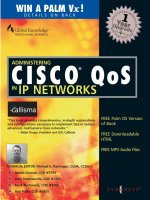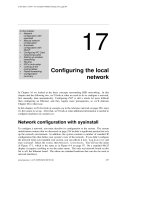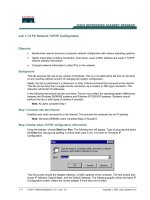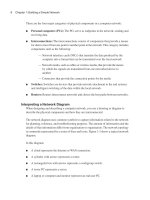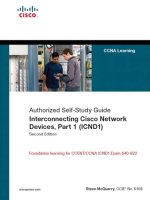Tài liệu Administering Cisco QoS in IP Network pdf
Bạn đang xem bản rút gọn của tài liệu. Xem và tải ngay bản đầy đủ của tài liệu tại đây (3.72 MB, 561 trang )
FREE Palm OS Version
of Book
FREE Downloadable
HTML
FREE MP3 Audio Files
Benoit Durand, CCIE #5754
Jerry Sommerville, CCIE #1293
Mark Buchmann, CCIE #3556
Ron Fuller, CCIE #5851
WIN A PALM Vx !
DETAILS ON BACK
CISCO QoS
ADMINISTERING
“This book provides comprehensive, in-depth explanations
and configurations necessary to implement QoS in today's
advanced, multiservice Cisco networks.”
—Ralph Troupe, President and CEO, Callisma
IP NETWORKS
®
IN
TECHNICAL EDITOR: Michael E. Flannagan, CCNA, CCDA
With over 1,500,000 copies of our MCSE, MCSD, CompTIA, and Cisco
study guides in print, we have come to know many of you personally. By
listening, we've learned what you like and dislike about typical computer
books. The most requested item has been for a web-based service that
keeps you current on the topic of the book and related technologies. In
response, we have created
, a service that
includes the following features:
■
A one-year warranty against content obsolescence that occurs as
the result of vendor product upgrades. We will provide regular web
updates for affected chapters.
■
Monthly mailings that respond to customer FAQs and provide
detailed explanations of the most difficult topics, written by content
experts exclusively for
.
■
Regularly updated links to sites that our editors have determined
offer valuable additional information on key topics.
■
Access to “Ask the Author”™ customer query forms that allow
readers to post questions to be addressed by our authors and
editors.
Once you’ve purchased this book, browse to
www.syngress.com/solutions.
To register, you will need to have the book handy to verify your
purchase.
Thank you for giving us the opportunity to serve you.
110_QoS_FM 2/13/01 4:42 PM Page 1
110_QoS_FM 2/13/01 4:42 PM Page 2
ADMINISTERING
CISCO Q
O
S
FOR IP NETWORKS
110_QoS_FM 2/13/01 4:42 PM Page 3
Syngress Publishing, Inc., the author(s), and any person or firm involved in the writing, editing, or production
(collectively “Makers”) of this book (“the Work”) do not guarantee or warrant the results to be obtained from the
Work.
There is no guarantee of any kind, expressed or implied, regarding the Work or its contents. The Work is sold
AS IS and WITHOUT WARRANTY. You may have other legal rights, which vary from state to state.
In no event will Makers be liable to you for damages, including any loss of profits, lost savings, or other inci-
dental or consequential damages arising out from the Work or its contents. Because some states do not allow
the exclusion or limitation of liability for consequential or incidental damages, the above limitation may not
apply to you.
You should always use reasonable case, including backup and other appropriate precautions, when working
with computers, networks, data, and files.
Syngress Media® and Syngress® are registered trademarks of Syngress Media, Inc. “Career Advancement Through
Skill Enhancement™,” “Ask the Author™,” “Ask the Author UPDATE™,” “Mission Critical™,” and “Hack
Proofing™” are trademarks of Syngress Publishing, Inc. Brands and product names mentioned in this book are
trademarks or service marks of their respective companies.
KEY SERIAL NUMBER
001 ALKJD48753
002 LERQAR9T83
003 ERQ395E932
004 45BHSKERF3
005 SLDFAPW93V
006 LWE432532R
007 36FCBFGK454
008 NVCW5DGK43
009 FJA495G8N3
010 4U34BRA395
PUBLISHED BY
Syngress Publishing, Inc.
800 Hingham Street
Rockland, MA 02370
Administering Cisco QoS for IP Networks
Copyright © 2001 by Syngress Publishing, Inc. All rights reserved. Printed in the United States of America.
Except as permitted under the Copyright Act of 1976, no part of this publication may be reproduced or dis-
tributed in any form or by any means, or stored in a database or retrieval system, without the prior written per-
mission of the publisher, with the exception that the program listings may be entered, stored, and executed in a
computer system, but they may not be reproduced for publication.
Printed in the United States of America
1 2 3 4 5 6 7 8 9 0
ISBN: 1-928994-21-0
Co-Publisher: Richard Kristof Freelance Editorial Manager: Maribeth Corona-Evans
Technical edit by: Michael E. Flannagan Index by: Robert A. Saigh
Technical Review by: Mark Buchmann Copy edit by: Beth Roberts and Juli Smith
Acquisitions Editor: Catherine B. Nolan Page Layout and Art by: Shannon Tozier
Distributed by Publishers Group West
110_QoS_FM 2/13/01 4:42 PM Page 4
v
Acknowledgments
We would like to acknowledge the following people for their kindness and support
in making this book possible.
Richard Kristof, Duncan Anderson, David Marini, Jennifer Gould, Kevin Murray, Dale
Leatherwood, Laura Cervoni, and Rhonda Harmon of Global Knowledge, for their
generous access to the IT industry’s best courses, instructors, and training facilities.
Ralph Troupe, Rhonda St. John, Emlyn Rhodes, and the team at Callisma for their
invaluable insight into the challenges of designing, deploying and supporting world-
class enterprise networks.
Karen Cross, Lance Tilford, Meaghan Cunningham, Kim Wylie, Harry Kirchner, Bill
Richter, Kevin Votel, Brittin Clark, and Sarah MacLachlan of Publishers Group West
for sharing their incredible marketing experience and expertise.
Mary Ging, Caroline Hird, Simon Beale, Caroline Wheeler,Victoria Fuller, Jonathan
Bunkell, and Klaus Beran of Harcourt International for making certain that our
vision remains worldwide in scope.
Anneke Baeten, Annabel Dent, and Laurie Giles of Harcourt Australia for all their help.
David Buckland,Wendi Wong, Daniel Loh, Marie Chieng, Lucy Chong, Leslie Lim,
Audrey Gan, and Joseph Chan of Transquest Publishers for the enthusiasm with
which they receive our books.
Kwon Sung June at Acorn Publishing for his support.
Ethan Atkin at Cranbury International for his help in expanding the Syngress program.
Joe Pisco, Helen Moyer, and the great folks at InterCity Press for all their help.
v
110_QoS_FM 2/13/01 4:42 PM Page v
vi
From Michael E. Flannagan,
Technical Editor
A world of thanks to the Cisco RTP Routing Protocols Team for an unbelievable
amount of knowledge, experience, assistance, and fun…you guys are the best! Thanks
to Matt Carling (Cisco Systems, Australia) for his assistance with our MPLS chapter.
Special thanks to Shannon Brown (Cisco Systems,TAC) for her knowledge and
especially her patience back in the days when I could hardly spell “router.” And, of
course, I’ll be disowned if I don’t say…Hi mom!
110_QoS_FM 2/13/01 4:42 PM Page vi
vii
From Global Knowledge
At Global Knowledge we strive to support the multiplicity of learning styles
required by our students to achieve success as technical professionals. As the
world's largest IT training company, Global Knowledge is uniquely positioned to
offer these books.The expertise gained each year from providing instructor-led
training to hundreds of thousands of students world-wide has been captured in
book form to enhance your learning experience.We hope that the quality of
these books demonstrates our commitment to your lifelong learning success.
Whether you choose to learn through the written word, computer based training,
Web delivery, or instructor-led training, Global Knowledge is committed to pro-
viding you with the very best in each of these categories. For those of you who
know Global Knowledge, or those of you who have just found us for the first
time, our goal is to be your lifelong competency partner.
Thank your for the opportunity to serve you.We look forward to serving your
needs again in the future.
Warmest regards,
Duncan Anderson
President and Chief Executive Officer, Global Knowledge
110_QoS_FM 2/13/01 4:42 PM Page vii
Michael E. Flannagan (CCNA, CCDA) is a Network Consulting
Engineer in the Network Supported Accounts (NSA) Group at Cisco
Systems and is a team lead for the MPLS/QoS Virtual Team. His experi-
ence includes extensive work with Routing Protocol and Quality of
Service support for customer networks. Prior to joining Cisco Systems, he
worked as an enterprise network architect and as a consultant specializing
in Quality of Service. Mike’s Quality of Service testing and research was
used to recommend the implementation of various QoS mechanisms for
one of the world’s largest pharmaceutical companies and he has partici-
pated in large-scale QoS designs for several major US companies. In addi-
tion to holding various certifications from Cisco, 3Com, and Nortel
Networks, Mike has passed both the CCIE Routing/Switching and the
CCIE Design written exams and is currently preparing for his CCIE Lab
exams. He lives in Morrisville, NC.
Technical Reviewer
Mark Buchmann (CCIE#3556, CCSI) is a Cisco Certified
Internetworking Expert and has been a Certified Cisco Systems
Instructor since 1995. He is the owner of MAB Enterprises, Inc., a com-
pany providing consulting, network support, training, and various other
services. Mark is also a co-owner of www.CertaNet.com, a company pro-
viding on-line certification assistance for a variety of network career paths
including all the various Cisco certifications. Mark is Series Editor for
Syngress Media’s Cisco Certification Study Guides.
In his free time he enjoys spending time with his family and boating.
He currently lives in Raleigh, NC.
viii
Technical Editor
110_QoS_FM 2/13/01 4:42 PM Page viii
ix
Contributors
Benoit Durand (CCIE #5754, CCNA, CCDA, CCNP, CCDP) is the
Midwest Region Network Engineer for Tivoli Systems (www.tivoli.com)
located in Indianapolis, IN. Ben designs and integrates high-end network
solutions for Tivoli’s worldwide operations while maintaining his own
Cisco-powered network in Indianapolis. He has over 10 years of net-
working engineering experience in a wide range of environments. Prior
to working at Tivoli, Ben worked on many high-profile military projects
for the Canadian Air Force, deploying wide-area network solutions to
peacekeeping forces in Kuwait,Yugoslavia, and other international loca-
tions. His latest projects involve Voice-over-ATM,Virtual Private Network
solutions, and Wide-Area Network switching. Ben lives with his wife Dr.
Christy Snider in Kingston, GA.
Ron Fuller (CCIE #5851, CCNP-ATM, CCNP-Voice, CCNP-Security,
CCDP, MCNE) is a Senior Systems Engineer with 3X Corporation. He
currently provides network design and implementation services to 3X
Corporation clients in the Eastern United States. His specialties include
Cisco LAN/WAN design, security consultation, and Novell network
design. He has held senior engineer positions for two other network con-
sulting companies in the past nine years. Ron also contributed to Syngress’
Building Cisco Remote Access Networks (1-928994-13-X). He currently
resides in Sunbury, OH with his wife, Julie, and his yet-to-be-born baby.
Jerry Sommerville (CCIE #1293) is a Senior Consultant for Callisma.
His background includes network management, system management,
system integration, network support and planning, user training, proce-
dure automation, and program analysis. Jerry holds a Master of Science in
Computer Aided Design & Computer Aided Manufacturing from Eastern
Michigan University and a Bachelor of Science in Industrial Technology
and Engineering from Texas A & M University.
110_QoS_FM 2/13/01 4:42 PM Page ix
x
James Placer (CCDP, CCNP Security,Voice Access, NNCDS, NNCSS,
MCSE) is a Senior Network Design Engineer at Interactive Business
Systems, Inc. in the Enterprise Networking Group (www.ibsentg.com).
He designs, troubleshoots, and implements large-scale LAN and WAN
networks based primarily on Cisco Systems and Nortel Networks plat-
forms. James previously contributed to the Syngress CCNP Support Study
Guide for Exam 640-506 and has over 14 years of experience in the net-
working and computer systems field. He currently resides with his wife
Kathy just outside the town of Allegan, MI.
Kevin Davis (CCNA, MCSE, MCP+I) is a Consultant with Callisma
where he consults with Service Providers and enterprise clients on var-
ious networking issues. Formerly, Kevin was a consultant with
International Network Services in Raleigh, NC working with Service
Providers in the Research Triangle Park (RTP). He graduated with a
degree in Computer Engineering from the Dwight Look College of
Engineering at Texas A&M University in College Station, TX.
Kevin also contributed to Syngress’ Building Cisco Remote Access Networks
(1-928994-13-X) and has written several whitepapers on minimizing
computer viruses in a network environment and browser security. He
lives in McKinney,TX.
Paul Salas (CCNA, MCT, MCSE, Network+) is a Senior Network
Engineer for Fleet Mortgage Corporation. Paul designs and manages
Fleet’s internetwork infrastructure, which consists of a wide variety of
networking equipment from an assortment of vendors. He currently is
involved in implementing a high-end Web network solution. He is also a
part-time technical instructor for Microstaff Corporation where he
delivers Microsoft Official Curriculum for the Windows 2000 track. Paul
lives in Columbia, SC with his family. He would like to dedicate his writ-
ings to his wife, Margaret, for tolerating his “hair on fire” work pace and
to his two children, Michael and Allison, Mountains are conquered one step at
a time.
110_QoS_FM 2/13/01 4:42 PM Page x
xi
Jeff Corcoran (CCNA, MCSE, CNE) is a Senior Network Consultant
for Siemens Enterprise Networks, Inc. where he is a network planner in
the Ford Motor Company Advanced Network Technologies group. He is
responsible for global network planning and testing of emerging network
technologies and their application to the Ford Intranet. He has a special
focus on VoIP, QoS, high availability architectures, and multicast. Jeff holds
a Bachelors of Science in Physics and Applied Mathematics from the
University of Toledo. He lives in Dearborn, MI.
Lisa Giebelhaus (CCNA) is a Senior Consultant with Callisma. She has
been in the Telecommunications field for eight years. Her main focus has
been designing, implementing, and managing projects for large-scale enter-
prise networks. Prior to joining Callisma, Lisa was a Senior Consultant for
Lucent NetworkCare Professional Services (formerly INS) in Detroit, MI.
She graduated from Michigan State University with a Bachelor of Science
degree in Engineering Arts. She lives in Royal Oak, MI.
Richard Hamilton is a Senior Consultant with Callisma. He is currently
responsible for leading engineering teams in the design and implementa-
tion of complex networks for service providers. Richard is industry rec-
ognized as a subject matter expert in MPLS, ATM, and Frame Relay
switching. Richard has spent 14 years providing technical services in the
financial and service provider industries for companies including NatWest
Bank, Fleet Bank, International Network Services, Lucent Technologies,
Cisco Systems, Sprint,WorldCom, South Western Bell, GTE, CapRock,
CTC Communications, ILD Telecommunications, and Triton PCS.
Richard also contributed to Syngress Publishing’s Building Cisco Remote
Access Networks (1-928994-13-X). He lives in Flower Mound,TX.
110_QoS_FM 2/13/01 4:42 PM Page xi
xii
Robert Melancon is a Consultant with Callisma. His recent projects
involve the maintenance of a 400+ site LAN/WAN implementing
TCP/IP, Frame Relay, 3COM hubs, Cisco Catalyst 1900 series switches,
and Cisco 2500 series routers. He has also worked on proof of concept
and certification of xDSL and WAN technologies and vendor equipment
including Promatory and Pairgain DSLAMs and Nortel and Lucent WAN
switches. Robert has also developed many training programs and docu-
mentation. He has a degree in engineering from Southern Methodist
University and lives in Dallas,TX.
110_QoS_FM 2/13/01 4:42 PM Page xii
Contents
xiii
Foreword xxiii
Chapter 1 Cisco IOS Feature Review 1
Introduction 2
IP Address Classes and Classful IP Routing 2
Classes A, B, and C 5
Class D Addresses (Multicast) 8
RIPv1 and IGRP 10
RIPv1 11
IGRP 13
Variable-Length Subnet Mask (VLSM) Review 17
Why Do We Need VLSM? 19
Common Uses for Subnetting 20
Standard Access Control Lists (ACLs) 21
Filtering Traffic 24
Configuration Examples 25
Extended Access Control Lists (ACLs) 25
Benefits of Extended ACLs 30
Common Ports Used with Extended ACLs 30
Configuration Examples 32
Network Address Translation (NAT) 35
Controlling NAT with ACLs 39
Dynamic versus Static Translations 39
Configuration Example 40
Route Maps 40
Where to Use Route Maps 41
Controlling Traffic with Route Maps 41
Configuration Example 41
Summary 43
FAQs 44
Chapter 2 EIGRP A Detailed Guide 47
Introduction 48
Reviewing Basic Concepts of IGRP 48
110_QoS_ToC 2/14/01 9:07 AM Page xiii
xiv Contents
How Does EIGRP Work? 50
Using Distance Vectors for Path Selection 50
Defining the Four Basic Components of EIGRP 57
Establishing Protocol-Dependent Modules 57
Establishing Neighbor Discovery/Recovery 58
Managing Reliable Transport Protocol 59
Establishing DUAL Finite State Machine 59
Implementing Packet Types 60
Configuring EIGRP’s Distributed
Update Algorithm (DUAL) 64
Choosing a Path Selection 64
Handling Failure and Recovery 72
Configuring Basic EIGRP 75
Verifying Configuration with Show Commands 84
Configuring Advanced EIGRP 87
Summarizing EIGRP Addresses 88
Redistributing EIGRP and OSPF 97
Unequal Cost Load Balancing 103
Recognizing Caveats 108
Stuck-in-Active 108
Auto-Summarization 109
Troubleshooting EIGRP 110
Troubleshooting Stuck-in-Active Routes 110
Troubleshooting Auto-Summarization 115
Troubleshooting not-on-common-subnet 117
Summary 119
FAQs 120
Chapter 3 Introduction to Quality of Service 123
Introduction 124
Defining Quality of Service 124
What Is Quality of Service? 125
Applications for Quality of Service 126
Three Levels of QoS 127
Understanding Congestion Management 129
Defining General Queuing Concepts 130
Leaky Bucket 131
Tail Drop 132
Token Bucket 133
First In First Out Queuing 134
Fair Queuing 136
Priority Queuing 138
Custom Queuing 139
110_QoS_ToC 2/14/01 9:07 AM Page xiv
Contents xv
Understanding Congestion Avoidance 141
Congestion Avoidance in Action 142
Pros and Cons of Congestion Avoidance 142
Introducing Policing and Traffic Shaping 143
Traffic Shaping 144
Generic Traffic Shaping 145
Frame Relay Traffic Shaping 145
Summary 145
FAQs 146
Chapter 4 Traffic Classification Overview 147
Introduction 148
Introducing Type of Services (ToS) 148
ToS Service Profile 150
Defining the Seven Levels of IP Precedence 151
Explaining Integrated Services 152
Defining the Parameters of QoS 154
Admission Requirements 155
Resource Reservation Requirements 156
Packet Classification 156
Packet Scheduling 156
Introducing Resource Reservation Protocol (RSVP) 156
RSVP Traffic Types 157
RSVP Operation 157
RSVP Messages 158
Reservation-Request Messages 158
Path Messages 158
Error and Confirmation Messages 159
Teardown Messages 159
Introducing Differentiated Service (DiffServ) 161
The DiffServ Code Point (DSCP) 162
Per Hop Behavior (PHB) 163
Best Practice Network Design 165
Expanding QoS: Cisco Content Networking 168
Application Aware Classification: Cisco NBAR 169
HTTP Classification 169
Citrix Classification 170
Supported Protocols 170
PDLM 174
NBAR Supported QoS Services 174
NBAR and Content Network Design Guidelines 175
Summary 176
FAQs 178
110_QoS_ToC 2/14/01 9:07 AM Page xv
xvi Contents
Chapter 5 Configuring Traffic Classification 181
Introduction 182
Configuring Policy-based Routing (PBR) 182
Using PBR to Route Specific Packet Types 184
Defining Committed Access Rate (CAR) 185
Configuring Distributed CAR (DCAR) 188
Marking and Transmitting Web Traffic 188
Remarking the Precedence Bit
and Transmitting Web Traffic 189
Marking and Transmitting Multilevels of CAR 190
Marking and Rate Limiting ISPs 191
Rate Limiting by Access List 193
Using CAR to Match and Limit by MAC Address 194
Monitoring CAR 196
Configuring Cisco Express Forwarding 196
Enabling CEF 197
Monitoring CEF 198
Troubleshooting Cisco Express Forwarding
Caveats and Bugs 200
Configuring Basic Network-based Application
Recognition (NBAR) 201
Creating an NABR Class Map 202
Creating a Policy Map 203
Applying the Policy Map to an Interface 203
Configuring Complex NBAR 204
Integrating NBAR with Class-based Weighted Fair Queuing 206
Creating a Class Map to Identify NBAR 207
Configuring Class Policy in the Policy Map 207
Attaching the Policy to an Interface 208
Configuring NBAR with Random Early Detection 209
Configuring System Network Architecture Type of Service 211
Mapping SNA CoS to IP ToS 211
Prioritizing SNA Traffic 212
Summary 213
FAQs 215
Chapter 6 Queuing and Congestion
Avoidance Overview 217
Introduction 218
Using FIFO Queuing 218
High Speed versus Low Speed Links 220
When Should I Use FIFO? 220
Using Priority Queuing 221
How Does Priority Queuing Work? 221
110_QoS_ToC 2/14/01 9:07 AM Page xvi
Contents xvii
Queue Sizes 222
Why Do I Need Priority Queuing on My Network? 222
Using Custom Queuing 224
How Does Custom Queuing Work? 224
Queue Sizes 226
Protocol Interactions with Custom Queuing 226
Why Do I Need Custom Queuing on My Network? 227
Using Weighted Fair Queuing (WFQ) 228
How Does Weighted Fair Queuing Work? 228
Where Does the Weight Factor Come into Play? 230
Resource Reservation Protocol (RSVP) 231
Why Do I Need Weighted Fair
Queuing on My Network? 231
Using Random Early Detection (RED) 232
How Does Random Early Detection Work? 232
TCP/IP Sliding Window 233
Why Do I Need Random Early
Detection on My Network? 235
Summary 235
FAQs 236
Chapter 7 Configuring Queuing
and Congestion Avoidance 239
Introduction 240
Configuring FIFO Queuing 240
Enabling FIFO 240
Verifying FIFO Operations 242
FIFO with RED 243
Configuring Priority Queuing 244
Enabling Priority Queuing 244
A Closer Look at the Protocol Classification 245
Applying Your Priority List to an Interface 247
Configuring the Queue Limits 247
Verifying Your Configuration 248
Troubleshooting Priority Queuing 250
Configuring Custom Queuing 252
Enabling Custom Queuing 252
Adjusting Byte Counts and Queue Sizes 254
Applying Your Configuration to an Interface 254
Verifying Your Configuration 255
Troubleshooting Custom Queuing 257
Configuring Weighted Fair Queuing 259
Enabling Weighted Fair Queuing 259
Verifying Your Configuration 260
Troubleshooting Weighted Fair Queuing 262
110_QoS_ToC 2/14/01 9:07 AM Page xvii
xviii Contents
Configuring Random Early Detection 263
Enabling Random Early Detection 263
RED with Other Queuing Mechanisms 264
Verifying Your Configuration 266
Troubleshooting Random Early Detection 267
Summary 267
FAQs 268
Chapter 8 Advanced QoS Overview 271
Introduction 272
Using the Resource Reservation Protocol (RSVP) 272
What Is RSVP? 273
What RSVP Is Not 275
How Does RSVP Work? 275
Session Startup 276
Session Maintenance and Tear-Down 278
What Kind of QoS Can I Request with RSVP? 279
Reservation Styles and Merging Flows 280
Why Do I Need RSVP on My Network? 282
Advantages of Using RSVP 283
Disadvantages of Using RSVP 283
Using Class-Based Weighted Fair Queuing (CBWFQ) 284
How Does CBWFQ Work? 284
Why Do I Need CBWFQ on My Network? 286
RSVP in Conjunction with CBWFQ 290
Using Low Latency Queuing (LLQ) 291
How Does LLQ Work? 291
Classifying Priority Traffic 292
Allocating Bandwidth 292
Limitations and Caveats 294
Why Do I Need LLQ on My Network? 294
Using Weighted Random Early Detection (WRED) 295
How Does WRED Work? 295
WRED and IP Precedence 296
WRED and RSVP 297
WRED Algorithm 297
Why Do I Need WRED on My Network? 298
Using Generic Traffic Shaping and Frame
Relay Traffic Shaping 299
Token Bucket 299
How Does GTS Work? 301
Why Do I Need GTS on My Network? 301
How Does FRTS Work? 303
Why Do I Need FRTS on My Network? 305
110_QoS_ToC 2/14/01 9:07 AM Page xviii
Contents xix
Running in Distributed Mode 307
Features Supported in Distributed Mode 307
IOS Versions 308
Operational Differences 308
Restrictions 308
Using Link Fragmentation and Interleaving 309
How Does LFI Work? 311
LFI with Multilink Point-to-Point Protocol 312
How Can This Be Useful on My Network? 313
Understanding RTP Header Compression 313
How Does RTP Header Compression Work? 314
When Would I Need RTP Header Compression? 315
Summary 315
FAQs 318
Chapter 9 Configuring Advanced QoS 321
Introduction 322
Enabling, Verifying, and Troubleshooting
Resource Reservation Protocol (RSVP) 322
Enabling RSVP 324
Verifying Your RSVP Configuration 324
Troubleshooting RSVP 327
Enabling, Verifying, and Troubleshooting
Class-Based Weighted Fair Queuing (CBWFQ) 328
Enabling CBWFQ 328
Defining Class Maps 328
Creating Policies 330
Attaching Policies to Interfaces 334
Verifying Your CBWFQ Configuration 334
Troubleshooting CBWFQ 336
Configuring, Verifying, and Troubleshooting
Low Latency Queuing (LLQ) 337
Configuring LLQ 337
Verifying Your LLQ Configuration 338
Troubleshooting LLQ 339
Configuring, Verifying, and Troubleshooting
Weighted Random Early Detection (WRED) 340
Configuring WRED 340
Verifying Your WRED Configuration 343
Troubleshooting WRED 348
Configuring and Verifying Generic Traffic
Shaping (GTS) and Frame
Relay Traffic Shaping (FRTS) 349
Configuring GTS 351
Verifying Your GTS Configuration 352
110_QoS_ToC 2/14/01 9:07 AM Page xix
xx Contents
Configuring FRTS 354
Enabling Frame Relay Traffic Shaping
on the Interface 354
Configuring Traffic Shaping Parameters 354
Configuring Queuing for the VC 356
Applying Map Class to the Frame Relay Interface 357
Verifying Your FRTS Configuration 357
Understanding Distributed Technologies 359
DCEF 360
DWRED 360
Configuring, Verifying, and Troubleshooting
Link Fragmentation and Interleaving (LFI) 362
Configuring LFI 362
Multilink PPP 362
LFI and Frame Relay 364
Verifying Your LFI Configuration 365
Troubleshooting MLP 366
Configuring, Verifying, and Troubleshooting
RTP Header Compression 367
Configuring RTP Header Compression 368
Verifying Your RTP Header Configuration 368
Troubleshooting RTP Header Compression 369
Summary 370
FAQs 372
Chapter 10 Overview: Border Gateway Protocol (BGP) 375
Introduction 376
The History of BGP 376
Exterior Gateway Protocol (EGP) 376
The Original Implementation 377
The Current RFC 378
Maximizing the Functionality of BGP 380
The BGP Routing Process 380
BGP Finite State Machine Logic 381
The Types of BGP Messages 384
The Format of BGP Packets 384
External BGP and the Internet 393
What Is an Autonomous System? 395
Does that Mean BGP Uses Hop Count? 397
Weight 397
How Do I Get There? 398
Multiexit Discriminator (MED), the BGP Metric 400
Local Preference 401
The BGP Path Selection Process 402
BGP Path Selection Example 403
110_QoS_ToC 2/14/01 9:07 AM Page xx
Contents xxi
Redistributing BGP into Your IGP 408
Redistributing the Default Route 409
BGP Synchronization 410
Defining Internal BGP, Route Reflectors, and Confederations 411
Internal BGP 412
Route Reflectors 412
Confederations 412
Advanced BGP Network Design 414
Building Network Redundancy 415
Common Design Methodologies 417
Summary 418
FAQs 419
Chapter 11 Configuring Border Gateway Protocol 421
Introduction 422
Relevant RFCs 422
Enabling BGP Routing 423
Defining BGP for an Autonomous System 424
Defining the Remote AS 425
Public versus Private Autonomous Systems 426
Enabling BGP Routing 426
Configuring EBGP Neighbors 427
Defining the Remote Version 428
Removing Private AS Numbers 429
Configuring IBGP Neighbors 432
Peering to Loopback Interfaces 432
Configuring Route Reflectors 433
Configuring Confederations 436
When Do I Need Route Reflectors and Confederations? 438
Weight, MED, LOCAL PREF, and Other Advanced Options 439
Route-Map, Match, and Set Commands 441
Weight Attribute 442
Setting the Weight Attribute Using the
Neighbor Statement 442
Setting the Weight Attribute Using Access Lists 443
Setting the Weight Attribute Using Route Maps 444
Multiexit Discriminate (MED) Attribute 444
Setting the MED Attribute Using the
Set Metric Command 445
Setting the MED Attribute with the
Default-Metric Command 446
Local Preference Attribute 446
Setting Local Preference with the Default
Local-Preference Command 447
110_QoS_ToC 2/14/01 9:07 AM Page xxi
xxii Contents
Setting the Local Preference Attribute with
the Set Local-Preference Command 448
AS_Path Attribute 448
Origin Attribute 449
Next_Hop Attribute 449
Other Advanced Options:
BGP Multiprotocol Extensions 450
Summary 454
FAQs 455
Chapter 12 Multiprotocol Label Switching (MPLS) 457
Introduction 458
Understanding MPLS 458
Label Switching Basics 460
That Sounds a Lot Like Routing! 463
Integrating MPLS into QoS 470
Ensuring MPLS Is Efficient and Reliable 470
Integrating ATM Classes of Service (CoS) with MPLS 471
Reducing Congestion with Traffic
Engineering and VPN 472
Standardizing MPLS for Maximum Efficiency 473
Deploying Link State Protocol Support 473
Integrating VPNs with BGP 474
Controlling MPLS Traffic Using Traffic Engineering 474
Deploying MPLS Using Cisco Express Forwarding 475
Unequal Cost Load Balancing 476
Configuring Loopback Interfaces 477
Integrating MPLS and Virtual Private Networking (VPN) 478
VPN Scalability 493
Reducing the Load on Network Cores 493
Summary 493
FAQs 494
Index 497
110_QoS_ToC 2/14/01 9:07 AM Page xxii
Administering Cisco QoS in IP Networks discusses IP Quality of Service (QoS) and
how it applies to Enterprise and Service Provider environments. It reviews routing
protocols and quality of service mechanisms available today on Cisco network
devices (routers, switches, etc.).This guide provides examples and exercises for a
hands-on experience to give you the background and necessary details to implement
these capabilities in your network today.
The business impact of QoS on major enterprises today ensures the delivery of
the right information necessary to the bottom-line success of the business. QoS
expedites the handling of mission-critical applications, while sharing network
resources with non-critical applications.Today, with Cisco products, QoS has finally
found its time by effectively providing algorithms to ensure delivery that was once
only promised.
Over the past couple of years, the number of methods or protocols for setting
quality of service (QoS) in network equipment has increased dramatically. Advanced
queuing algorithms, traffic shaping, and access-list filtering, have made the process of
choosing a QoS strategy a much more daunting task. All networks can take advantage
of aspects of QoS for optimum efficiency, whether the network is for a small corpo-
ration, an enterprise, or an Internet Service Provider (ISP).
Through Callisma’s skilled team of technology, operations, and project manage-
ment professionals, we enable today’s Enterprises and Service Providers to design and
deploy networks that deliver business value.We help our clients compete effectively
in the new e-business marketplace through strategic business planning, network
design, and implementation services.
—Ralph Troupe, President and CEO
Callisma
Foreword
xxiii
110_QoS_Frwd 2/14/01 8:53 AM Page xxiii
110_QoS_Frwd 2/14/01 8:53 AM Page xxiv


